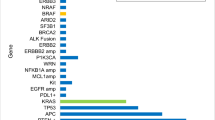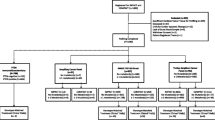Abstract
Background
Wilms tumor (WT) is the most common childhood kidney cancer worldwide, yet its incidence and clinical behavior vary according to race and access to adequate healthcare resources. To guide and streamline therapy in the war-torn and resource-constrained city of Baghdad, Iraq, we conducted a first-ever molecular analysis of 20 WT specimens to characterize the biological features of this lethal disease within this challenged population.
Methods
Next-generation sequencing of ten target genes associated with WT development and treatment resistance (WT1, CTNNB1, WTX, IGF2, CITED1, SIX2, p53, N-MYC, CRABP2, and TOP2A) was completed. Immunohistochemistry was performed for 6 marker proteins of WT (WT1, CTNNB1, NCAM, CITED1, SIX2, and p53). Patient outcomes were compiled.
Results
Mutations were detected in previously described WT “hot spots” (e.g., WT1 and CTNNB1) as well as novel loci that may be unique to the Iraqi population. Immunohistochemistry showed expression domains most typical of blastemal-predominant WT. Remarkably, despite the challenges facing families and care providers, only one child, with combined WT1 and CTNNB1 mutations, was confirmed dead from disease. Median clinical follow-up was 40.5 months (range 6–78 months).
Conclusions
These data suggest that WT biology within a population of Iraqi children manifests features both similar to and unique from disease variants in other regions of the world. These observations will help to risk stratify WT patients living in this difficult environment to more or less intensive therapies and to focus treatment on cell-specific targets.

Similar content being viewed by others
References
Stiller CA, Parkin DM. International variations in the incidence of childhood renal tumours. Br J Cancer. 1990;62:1026–30.
Breslow N, Olshan A, Beckwith JB, Moksness J, Feigl P, Green D. Ethnic variation in the incidence, diagnosis, prognosis, and follow-up of children with Wilms' tumor. J Natl Cancer Inst. 1994;86:49–51.
Al-Hadad SA, Al-Jadiry MF, Al-Darraji AF, Al-Saeed RM, Al-Badr SF, Ghali HH. Reality of pediatric cancer in Iraq. J Pediatr Hematol Oncol. 2011;33:S154–6.
Huff V. Wilms’ tumours: about tumour suppressor genes, an oncogene and a chameleon gene. Nat Rev Cancer. 2011;11:111–21.
Cancer Nusse R. Converging on beta-catenin in Wilms tumor. Science. 2007;316:988–9.
Gadd S, Huff V, Huang CC, Ruteshouser EC, Dome JS, Grundy PE, et al. Clinically relevant subsets identified by gene expression patterns support a revised ontogenic model of Wilms tumor: a Children’s Oncology Group Study. Neoplasia. 2012;14:742–56.
Lovvorn HN, Westrup J, Opperman S, Boyle S, Shi G, Anderson J, et al. CITED1 expression in Wilms’ tumor and embryonic kidney. Neoplasia. 2007;9:589–600.
Murphy AJ, Pierce J, de Caestecker C, Ayers GD, Zhao A, Krebs JR, et al. CITED1 confers stemness to Wilms tumor and enhances tumorigenic responses when enriched in the nucleus. Oncotarget. 2014;5:386–402.
Murphy AJ, Pierce J, de Caestecker C, Taylor C, Anderson JR, Perantoni AO, et al. SIX2 and CITED1, markers of nephronic progenitor self-renewal, remain active in primitive elements of Wilms’ tumor. J Pediatr Surg. 2012;47:1239–49.
Pode-Shakked N, Metsuyanim S, Rom-Gross E, Mor Y, Fridman E, Goldstein I, et al. Developmental tumourigenesis: NCAM as a putative marker for the malignant renal stem/progenitor cell population. J Cell Mol Med. 2009;13:1792–808.
Pierce J, Murphy AJ, Panzer A, de Caestecker C, Ayers GD, Neblett D, et al. SIX2 Effects on Wilms Tumor Biology. Transl Oncol. 2014;7:800–11.
Libes JM, Seeley EH, Li M, Axt JR, Pierce J, Correa H, et al. Race disparities in peptide profiles of North American and Kenyan Wilms tumor specimens. J Am Coll Surg. 2014;218:707–20.
Govender D, Harilal P, Hadley GP, Chetty R. p53 protein expression in nephroblastomas: a predictor of poor prognosis. Br J Cancer. 1998;77:314–8.
Lahoti C, Thorner P, Malkin D, Yeger H. Immunohistochemical detection of p53 in Wilms’ tumors correlates with unfavorable outcome. Am J Pathol. 1996;148:1577–89.
Shaw AP, Poirier V, Tyler S, Mott M, Berry J, Maitland NJ. Expression of the N-myc oncogene in Wilms’ tumour and related tissues. Oncogene. 1988;3:143–9.
Murphy AJ, Axt JR, de Caestecker C, Pierce J, Correa H, Seeley EH, et al. Molecular characterization of Wilms’ tumor from a resource-constrained region of sub-Saharan Africa. Int J Cancer. 2012;131:E983–94.
McKenna A, Hanna M, Banks E, Sivachenko A, Cibulskis K, Kernytsky A, et al. The Genome Analysis Toolkit: a MapReduce framework for analyzing next-generation DNA sequencing data. Genome Res. 2010;20:1297–303.
Cibulskis K, Lawrence MS, Carter SL, Sivachenko A, Jaffe D, Sougnez C, et al. Sensitive detection of somatic point mutations in impure and heterogeneous cancer samples. Nat Biotechnol. 2013;31:213–9.
Wang K, Li M, Hakonarson H. ANNOVAR: functional annotation of genetic variants from high-throughput sequencing data. Nucl Acids Res. 2010;38:e164.
Deng C, Dai R, Li X, Liu F. Genetic variation frequencies in Wilms’ tumor: a meta-analysis and systematic review. Cancer Sci. 2016;107:690–9.
Walz AL, Ooms A, Gadd S, Gerhard DS, Smith MA, Guidry Auvil JM, et al. Recurrent DGCR8, DROSHA, and SIX homeodomain mutations in favorable histology Wilms tumors. Cancer Cell. 2015;27:286–97.
Wegert J, Ishaque N, Vardapour R, Georg C, Gu Z, Bieg M, et al. Mutations in the SIX1/2 pathway and the DROSHA/DGCR8 miRNA microprocessor complex underlie high-risk blastemal type Wilms tumors. Cancer Cell. 2015;27:298–311.
Lovvorn HN 3rd, Pierce J, Libes J, Li B, Wei Q, Correa H, et al. Genetic and chromosomal alterations in Kenyan Wilms Tumor. Genes Chromosomes Cancer. 2015;54:702–15.
Takeuchi S, Bartram CR, Ludwig R, Royer-Pokora B, Schneider S, Imamura J, et al. Mutations of p53 in Wilms’ tumors. Mod Pathol. 1995;8:483–7.
Beckwith JB, Zuppan CE, Browning NG, Moksness J, Breslow NE. Histological analysis of aggressiveness and responsiveness in Wilms’ tumor. Med Pediatr Oncol. 1996;27:422–8.
Graf N, van Tinteren H, Bergeron C, Pein F, van den Heuvel-Eibrink MM, Sandstedt B, et al. Characteristics and outcome of stage II and III non-anaplastic Wilms’ tumour treated according to the SIOP trial and study 93-01. Eur J Cancer. 2012;48:3240–8.
Dome JS, Perlman EJ, Graf N. Risk stratification for wilms tumor: current approach and future directions. Am Soc Clin Oncol Educ Book. 2014;34:215–23.
Li CM, Kim CE, Margolin AA, Guo M, Zhu J, Mason JM, et al. CTNNB1 mutations and overexpression of Wnt/beta-catenin target genes in WT1-mutant Wilms’ tumors. Am J Pathol. 2004;165:1943–53.
Ruteshouser EC, Robinson SM, Huff V. Wilms tumor genetics: mutations in WT1, WTX, and CTNNB1 account for only about one-third of tumors. Genes Chromosomes Cancer. 2008;47:461–70.
Acknowledgements
The authors would like to thank Travis Clark and Holli Dicks for their technical assistance to conduct the next-generation sequencing analysis of these specimens.
Funding
This work was supported in part by the Carolyn Perot Rathjen Chair in Pediatrics at Vanderbilt (HF), the NIH/NCRR (Grant number G20 RR030956—VANTAGE Shared Resource at Vanderbilt), the NIH/NCI (Grant number 5R21CA155946-02), and the Vanderbilt Ingram Cancer Center Support Grant number 5P30 CA068485 (Translational Pathology Shared Resource).
Author information
Authors and Affiliations
Contributions
HMP wrote the manuscript, interpreted the data, and provided administrative and technical support. MFA designed the study, acquired data, provided administrative and technical support, and supervised the study. NMC wrote the manuscript, interpreted the data, and provided administrative and technical support. JMP developed the study methodology, acquired data, analyzed and interpreted the data, and provided administrative and technical support. BL analyzed and interpreted the data. QW analyzed and interpreted the data. RRF acquired data. HC acquired data. SU acquired data and provided administrative and technical support. HF designed the study. ARA acquired data and provided administrative and technical support. SAFA acquired data and provided administrative and technical support. AFA acquired data and provided administrative and technical support. RMA acquired data and provided administrative and technical support. SAA acquired data and provided administrative and technical support. HNL designed the study, developed the methodology, analyzed and interpreted the data, wrote the manuscript, and supervised the study. All authors approved the final version of the manuscript.
Corresponding author
Ethics declarations
Ethical approval
Approval to conduct these studies was provided through the Vanderbilt Institutional Review Board (#100734 and #020888).
Conflict of interest
The authors have no conflict of interests to disclose. No financial or nonfinancial benefits have been received or will be received from any party related directly or indirectly to the subject of this article.
Rights and permissions
About this article
Cite this article
Phelps, H.M., Al-Jadiry, M.F., Corbitt, N.M. et al. Molecular and epidemiologic characterization of Wilms tumor from Baghdad, Iraq. World J Pediatr 14, 585–593 (2018). https://doi.org/10.1007/s12519-018-0181-3
Received:
Accepted:
Published:
Issue Date:
DOI: https://doi.org/10.1007/s12519-018-0181-3




